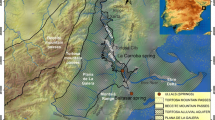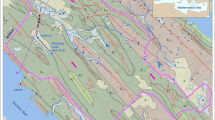Abstract
The Pingtung Plain is one of the most important groundwater-resource areas in southwestern Taiwan. The overexploitation of groundwater in the last two decades has led to serious deterioration in the quantity and quality of groundwater resources in this area. Furthermore, the manifestation of climate change tends to induce the instability of surface-water resources and strengthen the importance of the groundwater resources. Southwestern Taiwan in particular shows decreasing tendencies in both the annual amount of precipitation and annual precipitation days. To effectively manage the groundwater resources of the Pingtung Plain, a numerical modeling approach is adopted to investigate the response of the groundwater system to climate variability. A hydrogeological model is constructed based on the information from geology, hydrogeology, and geochemistry. Applying the linear regression model of precipitation to the next two decades, the modeling result shows that the lowering water level in the proximal fan raises an alarm regarding the decrease of available groundwater in the stress of climate change, and the enlargement of the low-groundwater-level area on the coast signals the deterioration of water quantity and quality in the future. Suitable strategies for water-resource management in response to hydrological impacts of future climatic change are imperative.
Résumé
La plaine de Pingtung est l’une des plus importantes zones de ressource en eau souterraine du Sud-Ouest de Taiwan. La surexploitation de l’eau souterraine durant les deux dernières décennies a conduit à une sérieuse détérioration de la quantité et de la qualité des ressources en eau souterraine dans cette zone. De plus, la manifestation des changements climatiques tend à induire une instabilité des ressources en eau souterraine et renforce l’importance des ressources en eau souterraine. Le Sud-Ouest de Taiwan montre, en particulier, des précipitations annuelles et des nombres annuels de jour de pluie à la baisse. Pour gérer efficacement les ressources en eau souterraine de la Plaine de Pingtung, une approche par modélisation numérique est adoptée pour étudier la réponse du système hydrogéologique aux variabilités climatiques. La construction du modèle hydrogéologique est basée sur les informations géologiques, hydrogéologiques et géochimiques. En appliquant le modèle de régression linéaire aux précipitations pour les deux prochaines décades, le résultat de la modélisation montre que la baisse du niveau d’eau atteint un état alarmant au regard de la décroissance des eaux souterraines disponibles et la contrainte du changement climatique, tandis que l’extension de la zone de niveau bas des eaux souterraines à la cote indique une détérioration de la quantité et de la qualité de l’eau dans le futur. Des stratégies convenables pour la gestion des ressources en eau souterraine en réponse aux impacts hydrologiques de futurs changements climatiques sont impératifs.
Resumen
La llanura Pingtung constituye uno de los recursos de aguas subterráneas más importantes en el Suroeste de Taiwan. La sobreexplotación de las aguas subterráneas en las dos últimas décadas ha dado lugar a un serio deterioro de la calidad y la cantidad de los recursos subterráneos en esta área. En particular el Suroeste de Taiwan muestra una tendencia decreciente en las cantidades de precipitación y en los días anuales de lluvia. Para gestionar de forma efectiva los recursos subterráneos en la Llanura Pingtung, se ha utilizado un modelo numérico aproximado para investigar la respuesta de las aguas subterráneas a la variabilidad climática. Un modelo hidrogeológico se construye a partir de la información geológica, hidrogeológica y geoquímica. Aplicando el modelo de regresión linear de la precipitación para las próximas dos décadas, el modelo resultante muestra que el descenso de los niveles de agua en el abanico proximal es alarmante, observándose el descenso del agua subterránea disponible en la presión del cambio climático, y el crecimiento del área de descensos de niveles de agua subterránea en la costa apunta a un deterioro de la cantidad y calidad del agua subterránea en el futuro. Se imponen pues, estrategias apropiadas para la gestión de los recursos hídricos en respuesta a los impactos hidrológicos del futuro cambio climático.







Similar content being viewed by others
References
Allen DM, Mackie DC, Wei M (2004) Groundwater and climate change: a sensitivity analysis for the Grand Forks aquifer, southern British Columbia, Canada. Hydrogeol J 12(3):270–290
Alley RB, Marotzke J, Nordhaus WD, Overoect JT, Peteet DM, Pielke RA Jr, Pierrehumbert RT, Rhines PB, Stocker TF, Talley LD, Wallace JM (2003) Abrupt climate changes. Science 299(28):2005–2010
Bredehoeft J (2005) The conceptualization model problem: surprise. Hydrogeo J 13(1):37–46
Brodie RS (1999) Integrating GIS and RDBMS technologies during construction of a regional groundwater model. Environ Model Softw 14:119–128
Central Geological Survey (CGS) (2002) Report on hydrogeology of the Pingtung Plain (in Chinese). Groundwater monitoring program in Taiwan (I), Ministry of Economic Affairs, Taipei, Taiwan
Deutsch CV, Journel AG (1998) Geostatistical Software Library and User’s Guide (GSLIB) 2nd edn., Oxford, New York
Freeze RA, Cherry JA (1979) Groundwater. Prentice-Hall, Englewood Cliffs, NJ
Healy RW, Cook PG (2002) Using groundwater levels to estimate recharge. Hydrogeol J 10:91–109
Hsu HH, Chen CT (2002) Observed and projected climate change in Taiwan. Meteorol Atmos Phys 79:87–104
Hydrogeologic Inc (1996) MODFLOW-SURFACT software, version 2.2, Hydrogeologic Inc., Hemdon, VA
Intergovernmental Panel on Climate Change (IPCC) (1995) Climate change 1995: synthesis report (summary for policymakers). United Nations Environment Program, Geneva
Intergovernmental Panel on Climate Change (IPCC) (2001) Climate change 2001: synthesis report (summary for policymakers). United Nations Environment Program, Geneva
Jyrkama MI, Skyes JF, Normani SD (2002) Recharge estimation for transient ground water modeling. Ground Water 40(6):638–648
Kennett-Smith A, Narayan K, Walker G (1996) Calibration of a groundwater model for the upper south east of South Australia. Divisional Report 96-2. CSIRO Division of Water Resources, Canberra, Australia
Narasimhan TN (2005) Hydrogeology in North America: past and future. Hydrogeol J 13(1):7–24
Piechota TJT, Tootle G (2004) The western US drought: How bad is it? Trans Am Geophys Union 85(32)301–304
Taiwan Provincial Water Conservancy Bureau (TPWCB) (1994) Compilation and analysis of existing groundwater and subsidence data of Taiwan, II, the Pingtung Plain (in Chinese). TPWCB, Taipei, Taiwan
Taiwan Provincial Water Conservancy Bureau (TPWCB) (1998) Study on the improvement of the Groundwater Monitoring System in the Pingtung Plain, Taiwan (in Chinese). TPWCB, Taipei, Taiwan
Ting C-S (1997) Groundwater resources evaluation and management for the Pingtung Plain, Taiwan. PhD Thesis, Free University, Amsterdam
Varni MR, Usunoff EJ (1999) Simulation of regional-scale groundwater flow in the Azul River Basin, Buenos Aires province, Argentina. Hydrogeol J 7(2):180–187
Wagener T, Sivapalan M, McDonnell J, Hopper R, Lakshmi V, Liang X, Kumar P (2004) Trans Am Geophys Union 85(44):451–457
Wang CH (2004) Precipitation changes and their impacts on the water resources management in Taiwan. Proceedings of the International Symposium on Hydrogeological Investigation and Remedial Technology, Chung-Li, Taiwan, 15–16 November 2004, pp 176–190
Water Resources Agency (WRA) (2004) Hydrological Year Book of Taiwan, Republic of China. Ministry of Economic Affairs, Republic of China, Taipei
Zhou Y, Ting CS, Liu CW (2003) Design of groundwater monitoring networks, with case study of the Pingtung Plain, Taiwan. Wu-Nan Books, Taipei
Acknowledgements
The National Science Council and Water Resource Agency of Taiwan are gratefully acknowledged for providing financial support to carry out the present work. The associate editor and reviewers are very much appreciated for their insightful comments.
Author information
Authors and Affiliations
Corresponding author
Rights and permissions
About this article
Cite this article
Hsu, KC., Wang, CH., Chen, KC. et al. Climate-induced hydrological impacts on the groundwater system of the Pingtung Plain, Taiwan. Hydrogeol J 15, 903–913 (2007). https://doi.org/10.1007/s10040-006-0137-x
Received:
Accepted:
Published:
Issue Date:
DOI: https://doi.org/10.1007/s10040-006-0137-x




